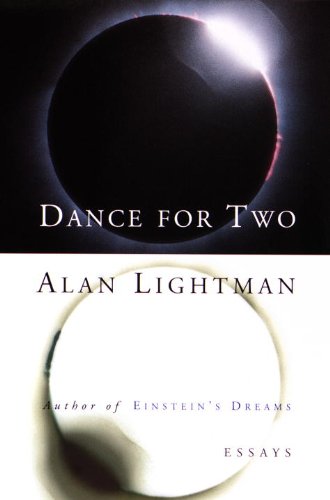Review: Dance for Two by Alan Lightman
Essays are an esoteric art form, and as E. B. White remarked, the most egotistic. Partaking of poetry, prose and process, they often capture only the fringe audience for each. Alan Lightman is one of the art’s most graceful modern performers, bringing literary and scientific concepts into harmony. In Dance for Two, twenty-four of his best essays are collected.
"A Day in December" chronicles an otherwise ordinary day in 1979 when Alan Guth, a 32-year-old physicist, discovered mathematical proof of the Big Bang. "Time for the Stars" uses Halley’s Comet, Newton and Galileo, Darwin and the Cro-Magnon cave paintings to argue for the value of investment in pure science research. "Is the Earth Round or Flat?" challenges us in a direct, illuminating—and entertaining—way to verify for ourselves even the most basic premises.
"If Birds Can Fly, Why, Oh Why, Can’t I?" evokes man’s yearnings for flight to explain the mechanics involved in the flight of birds.
In many ways, human beings circumvented the difficulties of aviation long ago, at Kitty Hawk… But in our dreams, when we soar into the air to escape danger, or to simply bask in our strength, we fly as birds, self-propelled. It may be awkward, to imagine ourselves installed with one hundred feet of wing, but that’s what Nature asks, to fly like a bird.
Readers may have encountered Lightman’s work in the “science fiction” novel Einstein’s Dreams. This book is less a story with a discernible plot than a series of essays centered on Einstein’s explorations of the nature of time. Lightman is uniquely equipped to illuminate Einstein’s musings—he is professor of both physics and writing at MIT.
My favorite essay in Dance for Two is the first in the book. "Pas de Deux" beautifully describes the delicate interaction of forces between gravity and the trained muscles of a ballet dancer:
In soft blue light, the ballerina glides across the stage and takes to the air, her toes touching Earth imperceptibly. Sauté, batterie, sauté. Legs cross and flutter, arms unfold into an open arch. The ballerina knows the easiest way to ruin a good performance is to think too much about what her body is doing…
While she dances, Nature is playing its own part, flawlessly and with absolute reliability. On pointe, the ballerina’s weight is precisely balanced by the push of floor against shoe, the molecules in contact squeezed just the right amount to counter force with equal force. Gravity balanced with electricity…
For an ending, the ballerina does a demi plié and jumps two feet into the air. The Earth, balancing her momentum, responds with its own sauté and changes orbit by one ten-trillionth of an atom’s width. No one notices, but it is exactly right.

No comments:
Post a Comment